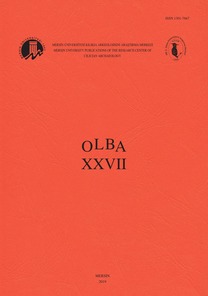GEÇ ANTİK DÖNEM KENTLERİNDE
GERİLEME/DEVAMLILIK MODELLERİNE
KANUNLAR ÜZERİNDEN BİR BAKIŞ
Roma İmparatorluğu’nun önemli değişimler geçirdiği Geç Antik Dönem’e ilişkin çalışmalar, dönemi iki ayrı teori üzerinden değerlendirmektedir: uzun süren bir gerileme sonucu imparatorluğun zayıflamasına bağlı yıkılışını öneren “gerileme” ve gerileme yerine dönüşümü koyarak çöküşü daha ileri bir tarihe öteleyen “devamlılık” teorileri. Gerilemenin varlığına dair veriler dönem yazılı kaynaklarından gelmektedir. Antik Greko-Romen kültürü oluşturan kurum ve geleneklerin birçoğunun yok olduğuna, devam edenlerin de önemli olumsuz değişimler geçirdiğine işaret eden güçlü bir hagiographia, historia ve codex külliyatı bulunmaktadır. Bunun karşılığında, devamlılık teorisyenleri son 40 yılın arkeoloji çalışmaları ile elde edilen fiziki buluntulardan yola çıkarak, söz konusu dönemde ani bir çöküş ve yaygın bir gerilemenin söz konusu olamayacağı görüşünü ileri sürmektedirler. Fiziki buluntular üzerinden yapılı çevrenin ele alınması ve devamlılık ya da gerilemenin tartışılması geçerli bir yöntemdir. Öte yandan bu çevreyi yaratan devamlılığı ya da gerilemesinde etkili olan sosyo-kültürel ortamın da ele alınması gereklidir. Bu çalışma söz konusu teorilerin tartışılmasında dönem insanın yapılı çevre algısını/kabulünü yeni bir parametre olarak önermektedir. Bir başka deyişle, bu kabulün söz konusu zaman aralığında geçirdiği değişimleri belirlemek ve bu değişimin yapılı çevreye etkilerini saptamaya çalışarak Geç Antik çağda Roma İmparatorluğunda kültürel bir gerileme ya da devamlılığın varlığına bir başka yorum getirmek amacındadır. Bu amaçla yakın zamanlı çalışmalarda şüpheyle yaklaşılan dönem kaynakları tekrar gündeme getirilmiştir. Araştırmaya temel kaynak olarak, dönemin yapılı çevresine ilişkin belirgin sorunlara doğrudan cevaplar olarak üretilmiş olmaları nedeniyle, Geç Antik Dönem kanunları alınmıştır. Bu kanunlarda her seviyeden halkın ve siyasal erkin, yapılı çevre algısına ayna tutan talepler, şikayetler, kabuller, çözümler yer almaktadır. Çalışma MS 438 yılında tamamlanan ve imparatorluğun gerileme/devamlılık süreci ile eşzamanlı yüz elli yıllık kanun külliyatını kapsayan Theodosius Codex’inde, yapılar, mimari çevrenin durumu ve korunması, yapı üretiminin aktörleri ve kaynakları ile ilgili kanunları, amaçları ve bağlamları ile sınıflandırmakta, bunlar üzerinden mimari çevrenin devamlılığına ilişkin bir değerlendirme yapmaktadır. Codex’de Antik dönemden miras kalan yapılı çevrenin ne kadar korunacağı ya da nasıl dönüşeceği konusunda etkili olacak kanunlar ele alınmış ve bu kanunların olası etkileri saptanmıştır.
A Re-Evaluation of Decline/Continuity Theories,
Based on the Late Antique Laws
The recent studies on Late Antique Period, through which Roman Empire experienced significant transformations, approach the subject by two major theories: “decline” which can be defined as fall of the empire after an arduous period of weakening; and “continuity” which substitutes decline with transformation and postpones the fall to a considerably later date. The evidence for decline is evident in the numerous literary sources in form of hagiographia, historia and codices. On the opposing side, the scholars advocating the continuity support their theories with the archaeological evidence. Interpreting the existence of a decline or continuity over the physical evidence of built environment is a valid and effective method. However it is also crucial to consider the socio-cultural context which created, protected or disregarded this environment. This paper proposes a new parameter in the discussion of continuity: the study of perception/understanding of the period towards built environment. In other words, it aims to bring forth a new interpretation toward the existence of continuity or decline, via determining the changing tastes and their effects on the built environment. With this aim, the study brings forward the written sources of the period once again, even though they need to be approached cautiously. Here the case is based on the corpus of Late Antique laws. Due to the process of their making, the laws provide direct answers to specific problems. The law codes include petitions, complaints, solutions and acceptances which display the people’s perception (especially of those who were effective on building activity) of the built environment. The paper focuses on Codex Theodosianus, which covers the law codes of c.150 years, coinciding with the period of either the continuity or the decline of the Roman culture. The codes, related to buildings, building activity, condition of the built environment, as well as those addressed the actors of building activity, are categorized according to their objectives and contexts. The analysis of the Codex paints a picture as follows: - Half built, un-tended, abandoned, decaying buildings constantly caused problems. - The local authority, were ineffective in maintaining the splendor of the Antique city, if not caused it to decay more. - Local aristocracy left the city, breaking the old patriotic bond which financially sustains the built environment - Artisans were lacking in number and skills. - The lacking material and financial sources were tried to be supplied to the expense of the Antique buildings. - The repetitive character of codes related to the preservation of Antique monuments or Antique city display the despair of even the imperial authority. What is evident from the analysis of the codex is that the socio-cultural environment which had been protecting and maintaining the Antique city was already dissolving in 4th century; even though the effects started to be felt within a hundred years time.
